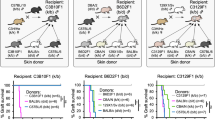Summary
In contrast to the zoological definition that wolf and dog belong to different species, it is shown by this study that in terms of immunology both species appear to be even closer related than DL-A compatible and MLC negative unrelated dogs. However, this close relationship is not expressed in DL-A or MLC tissue typing. Wolf skin-graft survival time in untreated dogs was 12,5, in AlG-treated dogs 85,6 days. The survival time in this system may be less dependent on DL-A or MLC histocompatibility than on other genetic systems, which are hitherto not sufficiently defined. An accidental, speciesspecific accordance in these systems may explain the obviously weak histocompatibility barrier between wolf and dog. It is concluded that in certain species-combinations xenotransplantation could be more successful than random allotransplantation. The availability of a xenogeneic species related to man similar as wolf to dog would markedly facilitate clinical xenotransplantation.
Zusammenfassung
Das zoologisch als xenogen bezeichnete System Wolf-Hund ist nach immunologischen Kriterien näher verwandt als DL-A-kompatible und MLC-negative unverwandte Hunde. Unbehandelte Hauttransplantate wurden nach 12,5 Tagen (Allotransplantate verwandter Hunde nach 9,1 Tagen) abgestoßen. Immunsuppression mit ALG verlängert diese Überlebenszeit erheblich auf 85,6, im Einzelfall über 200 Tage. Es liegt hier eine Spender-Empfänger-Kombination vor, deren schwache Histoinkompatibilität durch MLC und DL-A nicht zum Ausdruck kommt. Vermutlich ist sie durch andere genetische Systeme bedingt, die heute noch nicht zu bestimmen sind. Es konnte jedenfalls gezeigt werden, daß Transplantationen zwischen unterschiedlichen Spezies sogar mit besserem Erfolg als bei nicht verwandten Allotransplantaten möglich sind. Ziel der weiteren Forschung muß es sein, ein solches System auch für die menschliche Transplantation zu finden. Damit wären klinische Xenotransplantationen in größerem Ausmaß als bisher möglich.
Similar content being viewed by others
Literatur
BALNER, H.: Skin grafting in monkeys and apes. Transplantation8 206 (1969)
CHAUSSY, C., HAMMER, C., SCHEEL, J., v., PIELSTICKER, K., SOLLINGER, H.W., PFEIFFER, K.J., PONGRATZ, H., BRENDEL, W.: Xenogeneic skin and kidney transplants in a closely canine system, fox-dog. Transplantation20 150 (1975)
CHIARELLI, A.B.: The chromosomes of the canidae. In: The wild canids. (Ed. M.W. Fox) S. 40, New York: Van Norstrand Reinhold Comp. 1975
FOX, A.E., GAWLAK, D.L., BALLANTAYNE, D.L., jr., FREEDMAN, H.H.: Influence of Oxisuran, a differential inhibitor of cell-mediated hypersensitivity on allografts survival and humoral immunity. Transplantation16 389 (1973)
GROSSE-WILDE, H., BAUMANN, P., NETZEL, B., KOLB, H.J., MEMPEL, W., WANK, R., ALBERT, E.D.: One way nonstimulation in MLC to DL-A homocygocity. Transpl. Proc.5 1567 (1973)
HAMMER, C., CHAUSSY, C., KREBS, G., FIEDLER, H., PONGRATZ, H., BRENDEL, W.: A new concept for classification of xenograft rejection. Europ. Surg. Res.5 Suppl. 1, 19 (1973)
HAMMER, C., CHAUSSY, C., SCHEEL, J., v., PONGRATZ, H., ROSCHER, E., BRENDEL, W.: Survival times of skin and kidney grafts within different canine species in relation to their genetic markers. Transpl. Proc.7 439 (1975)
HECHTMANN, H.B., BLUMENSTOCK, D.A., THOMAS, E.D., FERREBEE, J.W.: Prolongation of canine skin homografts by antimetabolites. Surg. Forum13 55 (1962)
KISSMEYER-NIELSEN, F., KJEBYE, K.E.: Lymphocytotoxic microtechnique purification of lymphocytes by flotation. In: Histocompativility testing 1967, S. 381 Copenhagen: Munksgaard 1969
LANGE, E.M., DRESSER, D.W.: Antigenicity in mice of antilymphocyte gamme globulin. Nature (Lond.)215 488 (1967)
LAND, W., SEIFERT, J., FATEH-MOGHADAM, A., HOPF, U., BRENDEL, W.: Immunological tolerance induced in adult dogs by small amounts of horse IgG. Transplantation8 748 (1969)
LAND, W.: Möglichkeiten und Grenzen der xenogenen Organtransplantation. Der Chirurg42 172 (1971)
MÁLEK, P., KOLC, J., HASKOVÁ, V., ZÁSTAVA, V.: The effect of regional administration on the survival of skin allografts. Transplantation8 333 (1969)
PICHLMAYR, R.: Herstellung und Wirkung heterologer Antilymphocytenseren. Z. ges. exp. Med.143 161 (1967)
REEMTSMA, K., CRACKEN, B.H.MC., SCHLEGEL, J.W.et al.: Renal heterotransplantation in man. Ann. Surg.160 384 (1964)
VAN ROOD, J.J., VAN LEEUWEN, A., ZWEERUS, R.: In: Terasaki, P.J. (ed.): Histocompatibility testing 1970. S. 93, Copenhagen: Munksgaard 1970
RUBINSTEIN, P., MORGADO, F., BLUMENSTOCK, D.A., FERREBEE, J.W.: Isohaemagglutinins and histocompatibility in the dog. Transplantation6 961 (1968)
RUDOLPH, R.H., HERED, H., EPSTEIN, R.B., THOMAS, E.D.: Canine mixed leucocyte reactivity and transplantation antigens. Transplantation8 141 (1969)
SEAL, U.S.: Molecular approaches to taxonomic problems in the andidae. In: The Wild Canids. M.W. Fox (ed.). Molecular approaches to taxonomic problems in the canidae, S. 27 New York: Van Norstrand Reinhold Comp. 1975
STARZL, T.E., MARCHIORO, T.E., PETERS, G.N.: Renal Heterotransplantation. Transplantation2 752 (1964)
TERASAKI, P.J., McCLELLAND, J.: Microdroplet assay of human serum cytotoxins. Nature (Lond.)204 998 (1964)
THAN, M.M., BINA, P., MARTINEZ, C., ABSOLON, K.B.: The age factor and tolerance of full thickness skin homografts in normal or theymectomized canine littermates. Surg. Forum13 53 (1962)
WEITH, F.J., LUCK, R.J., MURRAY, E.J.: Splenectomy in immunosuppressive regimens in dog and man. Surg. Forum15 161 (1964)
WESTBROEK, D.L., VRIESENDORP, H.M., TWEEL, J.G. v.d., GRUYL, J., de, URK, H., v.: Influence of SD and LD matching on kidney allograft survival in unrelated mongrel dogs. Transpl. Proc.7 427 (1975)
Author information
Authors and Affiliations
Rights and permissions
About this article
Cite this article
Duswald, K.H., v. Scheel, J., Hammer, C. et al. Langzeitüberleben von Hauttransplantaten im xenogenen System Wolf-Hund. Res. Exp. Med. 167, 255–266 (1976). https://doi.org/10.1007/BF01851649
Received:
Issue Date:
DOI: https://doi.org/10.1007/BF01851649




